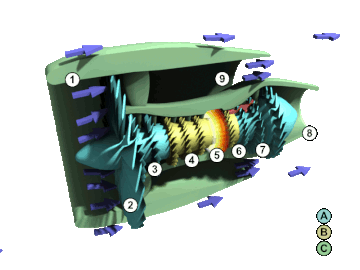Our website is made possible by displaying online advertisements to our visitors.
Please consider supporting us by disabling your ad blocker.
Turbofan

- Low-pressure spool
- High-pressure spool
- Stationary components
- Nacelle
- Fan
- Low-pressure compressor
- High-pressure compressor
- Combustion chamber
- High-pressure turbine
- Low-pressure turbine
- Core nozzle
- Fan nozzle
| Part of a series on |
| Aircraft propulsion |
|---|
|
Shaft engines: driving propellers, rotors, ducted fans or propfans |
| Reaction engines |
A turbofan or fanjet is a type of airbreathing jet engine that is widely used in aircraft propulsion. The word "turbofan" is a combination of references to the preceding generation engine technology of the turbojet and the additional fan stage. It consists of a gas turbine engine which achieves mechanical energy from combustion,[1] and a ducted fan that uses the mechanical energy from the gas turbine to force air rearwards. Thus, whereas all the air taken in by a turbojet passes through the combustion chamber and turbines, in a turbofan some of that air bypasses these components. A turbofan thus can be thought of as a turbojet being used to drive a ducted fan, with both of these contributing to the thrust.
The ratio of the mass-flow of air bypassing the engine core to the mass-flow of air passing through the core is referred to as the bypass ratio. The engine produces thrust through a combination of these two portions working together. Engines that use more jet thrust relative to fan thrust are known as low-bypass turbofans; conversely those that have considerably more fan thrust than jet thrust are known as high-bypass. Most commercial aviation jet engines in use are of the high-bypass type,[2][3] and most modern fighter engines are low-bypass.[4][5] Afterburners are used on low-bypass turbofan engines with bypass and core mixing before the afterburner.
Modern turbofans have either a large single-stage fan or a smaller fan with several stages. An early configuration combined a low-pressure turbine and fan in a single rear-mounted unit.
- ^ Marshall Brain (April 2000). "How Gas Turbine Engines Work". howstuffworks.com. Retrieved 2010-11-24.
- ^ Hall, Nancy (May 5, 2015). "Turbofan Engine". Glenn Research Center. NASA. Retrieved October 25, 2015.
Most modern airliners use turbofan engines because of their high thrust and good fuel efficiency.
- ^ Michael Hacker; David Burghardt; Linnea Fletcher; Anthony Gordon; William Peruzzi (March 18, 2009). Engineering and Technology. Cengage Learning. p. 319. ISBN 978-1-285-95643-5. Retrieved October 25, 2015.
All modern jet-powered commercial aircraft use high bypass turbofan engines [...]
- ^ Cite error: The named reference
Verma2013was invoked but never defined (see the help page). - ^ Frank Northen Magill, ed. (1993). Magill's Survey of Science: Applied science series, Volume 3. Salem Press. p. 1431. ISBN 9780893567088.
Most tactical military aircraft are powered by low-bypass turbofan engines.
Previous Page Next Page


